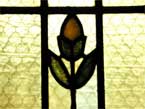History
The Beginning
Wellington Avenue United Church of Christ was born as an amalgamation of two congregations (The Evanston Avenue Congregational Church and the Lincoln Park Congregational Church) which, on May 20, 1909, organized the Wellington Avenue Congregational Church of Chicago. It was this uniting congregation that bought the property and built the present church building. Work on the building was begun July 14, 1910; the cornerstone was laid on November 24, 1910; services were held in the unfinished house of worship in December of 1910 (in Baird Hall). The first regular morning service was held in Baird Hall in January of 1911. The first service in the completed sanctuary was on October 22, 1911.
The first pastor for the newly formed church was Dr. Benjamin F. Aldrich, who was the last pastor for the Lincoln Park Congregational Church.
The Scrooby Font
The Scrooby font, the baptismal font which stands in the front of the sanctuary at Wellington, dates back to the 14th century and was used in the village church in Scrooby, England. The font is significant historically becasue William Brewster, later called "the chief of the Pilgrims," was a resident of Scrooby in the early 1570s and from 1588 until 1607. Soon after the death of his father in 1590, William Brewster was appointed to the position previously held by his father, "Master of the Postes," bailiff and receiver in Scrooby. He served in this position until September 30, 1607. During this period, Brewster apparently joined the Gainsborough Church which was led by John Smyth, a leader of the Separatist Movement. When Mr. Smyth was forced to leave England because of his beliefs, the remaining Separatist members began to hold their meetings in the Scrooby Manor House, the residence of William Brewster and his family.
William Brewster, after a period of imprisonment in Boston, England, reached Amsterdam in 1608 with several other leaders of the Scrooby church and joined John Smyth and others who had emigrated earlier. A year later he and some members of the group moved to Leyden. In 1620 a number of Separatist church members including Brewster, who was by now the Elder of the group, met briefly again in the Scrooby Manor House to form a "separate and independent church" and then sailed on the first voyage of the Mayflower. The men, women and children on this voyage to America founded the Plymouth Colony in what is now Massachusetts and became known as the Pilgrims. The religious and spiritual beliefs and practices of these people formed the foundation of the Congregational Church in America. In a real sense then, our roots can be traced to those wo stood around this gray granite font in Scrooby, England.
In 1881, Mr. William H. Bradley, who was a member of the New England Congregational Church in Chicago, was traveling to England. On that visit he met Lady Lowther who had knowledge of the Scrooby Church. It appears that some years earlier this church had been renovated and that while the base of the font now supported a newly designed bowl, the font itself was now unused and stored away. It struck Mr. Bradley that if he could acquire this historic font for the New England Church, it would serve as a fitting memorial to his daughter, Mary, and her two infant sons, all of whom had died recently before his trip to England. Lady Lowther made arrangements with Lord Houghton, the proprietor of the Scrooby estates, and with the Warden of the Scrooby Church. On March 1, 1882, Mr. Bradley formally presented the Scrooby font to the New England Church.
On July 14, 1936, the building of the New England Congregational Church burned. The Scrooby font was saved from the fire and the Wellington Avenue Congregational Church was asked to be its custodian in order that "it may be conserved and used to the glory of God." The font was formally given to Wellington Church on February 25, 1942.

Home
|



